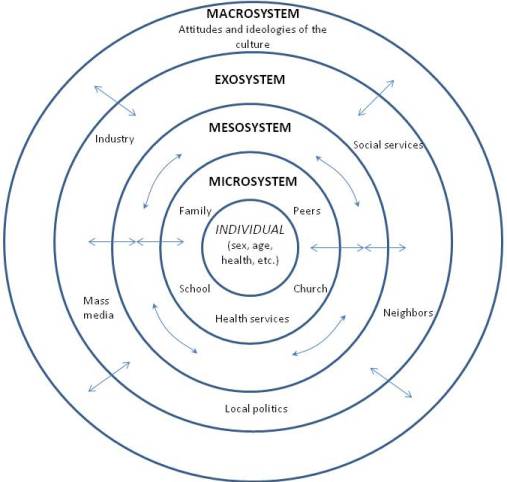10.1 Defining the Social Context
Learning Objectives
Type your learning objectives here.
- Explain the components of Bronfenbrenner’s ecological theory.
- Identify examples to represent the levels of the social context according to Bronfenbrenner’s theory.
Bronfenbrenner’s ecological theory emphasizes the social context in which children live. Bronfenbrenner (1995, 2000, 2004) proposed five environmental systems that impact the development of a child. These are illustrated in Figure 10.1. The inner-most circle represents the individual child. The microsystem represents the context in which direct interactions the child has with other individuals. This includes contacts with parents, peers, and teachers. These are reciprocal interactions. Within the mesosystem is the environmental system linkages occur between microsystems. An important connection within this system for cognitive development is the communication between families and schools. The exosystem is a setting where the child does not have a direct, active role. These include agencies or school boards that influence individuals who do have contact with the child. The macrosystem represents the broader culture. Within this system, Bronfenbrenner includes ethnicity and socioeconomic factors, such as poverty.

Long Description
Description of the image
Title: Bronfenbrenner’s Ecological Theory of Development
4 circles within 1 big circle. Arrows included between circles to show connectedness.
Outermost ring to Innermost part:
- Macrosystem – attitudes and ideologies of the culture
- Exosystem – Industry, Mass media, Social services, Neighbors, Local politics
- Mesosystem
- Microsystem – Family, Peers, School, Church, Health services
- Individual – [sex, age, health, etc]
Bronfenbrenner’s theory is useful as an organizing tool to think of levels of social influence from the immediate to more far reaching. It is helpful in emphasizing that children interact in multiple settings and that each of these settings can influence a child and other settings. However, this theory doesn’t explain how that socializing influence occurs. It also doesn’t explain how changes occur across development.
Exercises
Test yourself.
